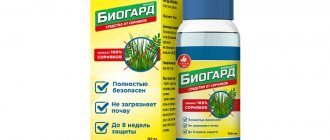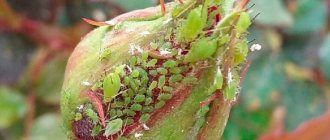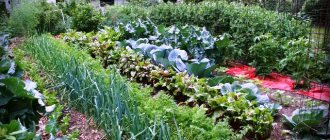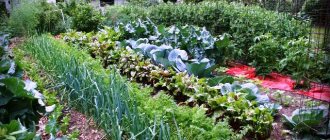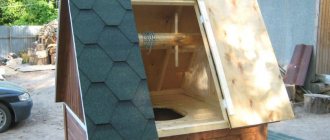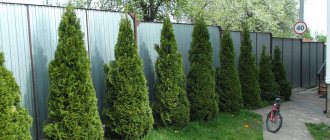Anyone who grows vegetables or flowers in their garden plots always faces the problem of weeds taking over the beds and flower beds with cultivated plantings. A weed killer can help when regular weeding doesn't stop the pesky grass from growing.
To get a good harvest, you need to control the growth of weeds and destroy them in a timely manner. This process is not easy. A good weed and grass killer will forever clear the fertile soil of harmful plants and bushes.
How to fight weeds in the garden
In any garden, in addition to vegetables and berry crops, weeds actively grow - wild plants that take away water, nutrients and even sunlight from cultivated plantings. Any weeds that appear must be destroyed. If you do not pay attention to them, then in a very short time the garden may become overgrown, and you will no longer be able to get a harvest.
In general, methods for killing weeds can be divided into 2 categories:
- Chemical method. Cultivated plantings or soil prepared for them are treated with special solutions that prevent the growth of weeds. The good thing about this method is that no weeds appear on the site after treatment with herbicides. However, chemicals against weeds also have a disadvantage; most often, only “empty” land can be treated with chemicals, in which vegetables and other crops have not yet been planted.
- Mechanical method. In this case, weed control comes down mainly to weeding the soil - harmful plants that have emerged from the ground are pulled out by the roots, not allowing them to grow. The method is very reliable and allows you to destroy existing weeds, but it requires significant and constant effort, since the weeds grow back quickly and in large quantities.
You can also permanently destroy weeds by mulching and covering the beds. The greatest effect can be achieved by combining all of the above means, in which case the fight turns out to be purposeful and truly effective.
Complex methods for solving the problem
Elimination of parasitic crops is a constant process that awaits gardeners year after year. Depending on the degree of contamination, you can select the optimal option for pest resistance. But experts say that:
- crop rotation will help by 65% or more;
- herbicides – up to 90%;
- green manure – by 30%;
- mechanical cultivation with moldboard and non-moldboard methods - up to 60%.
But the most effective is the use of this entire range of actions, ensuring up to 100% effectiveness.
Best Weed Killer Chemicals
The most popular among summer residents are modern chemical preparations for killing grass and weeds, the so-called herbicides. The area usually has to be cultivated before planting crops, but subsequently weed control is reduced to a minimum. Herbicides are well suited for treating very large or heavily overgrown gardens; limiting ourselves to weeding alone is simply irrational.
Lapis lazuli
A drug called Lapis Lazuli is excellent for destroying weeds in areas where it is planned to plant nightshades - potatoes, tomatoes or peppers.
The weed killer in the garden is effective on cereal plants and dicotyledonous annuals, and it can be used even if nightshade crops are already growing in the beds. “Lapis lazuli” will help destroy weeds, but will not cause damage to potatoes and tomatoes.
To remove weeds from the garden, it is recommended to treat the beds with Lazurite twice - before planting the seeds and a month after germination. Typically, a package of the product is diluted in 1 liter of water, after stirring, another 5 liters of liquid are poured in and the soil is sprayed with the solution.
Tornado
The main active ingredient of the herbicide is isopropylamine salt. When it gets on the above-ground parts and roots of weeds, the substance blocks the vital processes of the grass and leads to its death. A weed killer, diluted in a ratio of 25 ml per 1 liter of water, helps destroy more than 150 species of pest plants and copes not only with annuals and perennials, but even with shrubs. Annual weeds die just 5 days after spraying according to the instructions, and shrubs die off after about a month.
Attention! Tornado is a continuous action product - this means that it is necessary to treat the soil against weeds with a chemical solution before planting crops. Otherwise, the product can destroy both weeds and crop seedlings.
Hurricane Forte
A product called “Hurricane Forte” helps to destroy perennial and annual weeds even in heavily overgrown areas. A solution for killing weeds, which contains potassium salt, is diluted in 10 liters of water in an amount of 30 ml and sprayed over the entire area. Weeds disappear completely after 2-3 weeks, and re-treatment in the current season is usually no longer required.
Hurricane Forte is a continuous action product, but the drug has a detrimental effect on the roots, stems and leaves of plants. For cultivated seeds embedded in the soil, the product is completely harmless; the main thing is to treat the area before the first shoots emerge from the ground.
Roundup
Roundup has always been considered one of the best weed and grass killers. It contains glyphosate, or isopropylamine salt, and when sprayed over an area in a concentration of 60-120 ml per bucket of water, it penetrates the leaves and shoots of wild weeds. Vital processes in plant tissues are blocked, and weeds die en masse within 10 days after treatment.
The advantages of Roundup are that it is harmless to the soil and is also safe for pets. It is best to chemically destroy weeds in the garden in early spring, while there are still no shoots in the beds. When using weed control in the subsequent period, it is recommended to cover the cultivated plants with impermeable material.
Saltpeter
A very affordable and effective tool that helps destroy weeds is ordinary ammonium nitrate. It is beneficial to use it not only because saltpeter burns the vast majority of plant pests. The advantage also lies in the fact that the substance settles in the soil and then acts on crops as a fertilizer. Nitrogenous substances in ammonium nitrate are especially useful for garden plants in early spring; they contribute to the rapid development of seedlings.
To destroy weeds in the garden forever or for a very long time, use a very powerful concentration of saltpeter - about 3 kg of the substance per bucket of water. You can treat the area with this solution only before planting the seeds. But just a few days after treatment, the bulk of the nitrate will simply evaporate into the atmosphere, and a safe amount of nitrogen for plants will remain in the soil.
Agrotechnical techniques
Based on the biological characteristics of the growth of various crops. Weed control occurs using scientifically based methods.
Sideration
Plants that are planted as green manure sprout quickly, have a powerful root system and high growth potential, suppressing the growth of weeds.
The most suitable for weed control are:
- Legumes - lupine, alfalfa, vetch, peas. Plants provide large amounts of biomass.
The deep root system lifts nutrients from the lower layers of the earth. The nodules on the roots contain bacteria that obtain nitrogen from the air and saturate the soil with it. - Cruciferous - white mustard, oilseed radish, rapeseed. Plants release phytoncides and essential oils, disinfect the soil, reduce acidity, and improve its water and moisture permeability. Good honey plants.
- Cereals - rye, wheat, oats. They cope with the most malicious weeds: wheatgrass, sow thistle, horse sorrel.
They improve the structure of the soil and saturate it with potassium. It is recommended to sow uncultivated areas with rye.
Green manure is planted in empty beds after harvesting from the end of July to September. Without waiting for flowering, the green mass is mowed and embedded into the soil at a shallow depth or left on the soil surface as mulch.
Liming
Some weeds - horsetail, horse sorrel, plantain - prefer acidic soils. Regular application of lime or dolomite flour in autumn and spring lowers the pH of the soil to slightly acidic or neutral. At the same time, weeds disappear on their own.
Compacted plantings
An agrotechnical technique that consists of planting well-combined plants in a garden bed with different timing of seed germination and fruit ripening. Most often, compactors are planted in beds with carrots and parsley, the seeds of which take a long time to germinate. Radishes, spinach, and lettuce are planted between the rows.
Joint plantings of corn with beans or pumpkin, for which the grain serves as an additional support, go well.
The garlic is packed with eggplant and pepper. Garlic heads are harvested in July, and nightshades bear fruit until the cold weather.
On a note! Flowers that play the role of protectors against pests and diseases are often planted as sealants: marigolds, calendula, nasturtium.
Weeding and digging
Even the most thorough treatment of an area with chemicals does not always help to completely destroy weeds. Many herbicides act on the above-ground parts of weed plants, but the roots and seeds of weeds can survive.
During the entire growing season, it is recommended to carefully inspect the beds with cultural plantings. The soil at the roots of cultivated plants and between the rows is weeded, loosened and dug up at least once a month. Loosening the soil does not allow weeds to take root and grow properly. Unwanted seedlings can be destroyed at a very early stage.
Safety precautions
When processing a vegetable garden or garden, it is important to observe safety precautions, since the listed chemicals are toxic and, if inhaled or in contact with the skin and mucous membranes, can cause burns and poisoning.
Watering or irrigation is carried out in dry, windless weather. You need to check in advance whether there are any children or animals nearby: they must be removed from the work area. For irrigation you will need gloves, a face mask or respirator, and protective clothing. A spray bottle or garden sprayer is suitable for spraying solutions in dacha areas. After finishing work, you need to thoroughly wash your hands and wash your face.
Timely treatment of your garden or vegetable garden with herbicides will help get rid of a large number of weeds. In the future, it will be much easier to maintain the cleanliness of the beds using mechanical methods, since the main part of the parasitic herbs will be destroyed at the preliminary stage.
Mulching
Another effective agrotechnical method for removing weeds from the garden is mulching. The ground in the immediate vicinity of the roots of cultivated plants is covered with a dense layer of mulch - sand, peat, sawdust, wood chips.
Mulching does not harm the plantings themselves, provided that seedlings have already appeared in the garden bed, and especially cannot destroy them. On the contrary, a mulch layer is very useful - it prevents moisture from evaporating too quickly from the soil. But weeds cannot grow through the mulch layer; they do not receive the light and oxygen necessary for development, and they die at the stage of development underground.
Harm
Favorable conditions for the development of fungi, pests, diseases
Damage caused by unwanted vegetation to planted crops:
- interfere with their germination
- compete with them for everything necessary for life
- By thickening the plantings, they impair the passage of air, creating favorable conditions for fungi and pests
- can cause the development of diseases
Covering material and black film
You can fight weeds in your summer cottage with the help of covering material that is spread over the beds. Lutrasil and spunbond, agrotex and agrospan are in great demand on the horticultural market. Black opaque film is also often used to cover plantings. Any of the listed materials can be used for several years in a row and not have to worry about the weed problem.
Covering material acts in much the same way as mulch - it blocks the weeds from accessing sunlight and oxygen, thereby helping to destroy them. In this case, ordinary garden plants grow through special holes made in the covering material or film.
Peculiarities:
- Non-woven covering materials usually allow water to pass through, so you can water the beds directly through them.
- The black film is impervious to water and requires lifting or pouring water directly next to the plant stems when watering it.
- However, for plantings covered with film, watering itself is required much less frequently - the liquid evaporates more slowly from the soil, and condensation forms on the inner surface of the film, which returns to the ground.
Black covering materials help raise the temperature of the top layer of soil. This is also useful for cultivated plants - plantings suffer less from sudden cold snaps and bring more abundant harvests. During ripening, vegetables and berries do not get dirty in wet soil, but lie on a clean film, and it is much more convenient to collect them.
Important! Although film and other covering materials help destroy weeds, their disadvantage is that it becomes more difficult to fertilize the beds. And for digging and loosening the soil, it is completely necessary to remove the material. But at the same time, feeding plants under film or agrofibre is generally required less often.
Benefit
Staying together is unacceptable
Most types of weeds are valuable forage flowers and honey plants. They are actively used for food and medicine.
But it is impossible to combine fruit and berry and garden crops with grass that is suitable for preparing food or useful for an apiary . For the most beneficial use of the territory, summer residents destroy unwanted plants on their plots.
Folk remedies for weeds on the site
You can also destroy harmful plants using traditional methods - over the years of use they have proven their effectiveness. True, it is difficult to treat large areas of land with folk remedies for weeds at home, since a lot of raw materials will be needed to prepare solutions. But in a modest garden they can show good results.
Salt and vinegar
A homemade herbicide solution consisting of two ingredients - vinegar and salt - works well to destroy weeds in the garden. It is prepared in this way:
- 2 large tablespoons of salt are diluted in 1 liter of water;
- add 5 large tablespoons of table vinegar;
- heat the solution until hot and treat the soil, making sure that the mixture does not fall on crop plants.
The folk remedy is quite safe for vegetables and other crops. However, the soil will become very acidic after vinegar, so it will need to be fertilized with wood ash.
Soda and laundry soap
Another method suggests preparing weed poison at home from laundry soap and soda. In a bucket of water you need to dissolve 1 handful of soda powder and a grated piece of soap, and then stir thoroughly until completely dissolved.
The resulting product is used to purposefully water the weed thickets - the alkaline solution helps to reliably destroy the weeds. However, it is impossible to plant garden plants in this area during the season, and if weeds are destroyed away from vegetable crops, then you need to ensure that the gap is at least 20 cm.
Alcohol solution
Alcohol gives a good effect when treating areas overgrown with weeds. The product is diluted with water in a ratio of 1 to 10 and thoroughly poured onto the soil. Moreover, in order to destroy weeds on just 2 acres of land, you will need to spend a total of 11 liters of alcohol.
But the advantage of this method is that alcohol does not cause long-term damage to the soil. Within a month after treatment, vegetables and berries can be planted on the site.
Salt
One of the most effective folk remedies for weed control is salt; it has been used for decades. Salt is used in two ways:
- diluted in water at the rate of 1 kg per 10 l;
- sprinkle the soil with salt powder in a volume of 150 g per meter of space.
Weeds cannot tolerate the effects of salt and die very quickly, and then do not appear again for a long time. However, a significant disadvantage of the product is that it will not be possible to plant vegetable crops on land treated with salt for a very long time.
If you want to kill weeds with salt without harming the vegetables, you can dilute the product with water in a ratio of 3 to 1 and precisely water the ground exactly where the weeds grow, but not close to the garden crops.
Boiling water
Simple boiling water has a detrimental effect on germinating weeds. Scalding helps quickly destroy harmful weeds. This remedy should not be used only when weeds grow close to vegetables. The roots are too close, hot water can destroy them too.
Reviews from gardeners
This is how I fight weeds in a flower garden. I painstakingly and thoroughly free the area of the future flower garden from perennial weeds. And then I DO NOT KEEP THE EARTH BARE. everything is under mulch. Well, what kind of mulch is there - where is the leaf, where is the grass from the mower, where are the wood chips from the shredder. Peat and compost are EXCLUDED (as mulch - don’t be alarmed :)). Weeds grow on them like forests. Mulch prevents weed seeds from sprouting. Outside the flower beds, I cover the prepared areas with cardboard and black non-woven fabric (the weed disappears in 2 years, only pitiful stubs remain). It’s ugly, but at least I didn’t die on the battlefield.
Just kvass
https://forum.prihoz.ru/viewtopic.php?t=1253
Vinegar is not used to water the soil in barrels. Just spray on the leaves. And I, as not a chemist, will tell you even without chemistry that vinegar still decomposes into carbon dioxide and water. Especially in hot and sunny weather. Therefore, you can use it, which is what I do.
Petrovich
https://forum.prihoz.ru/viewtopic.php?t=745
